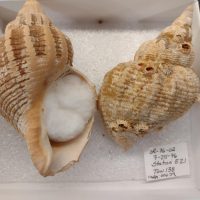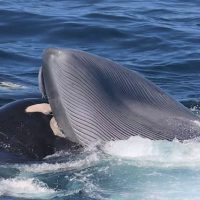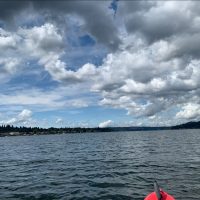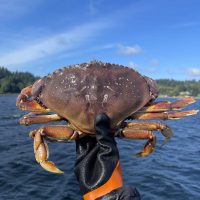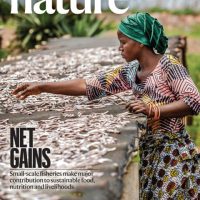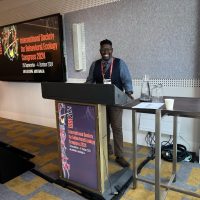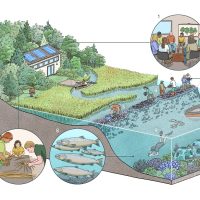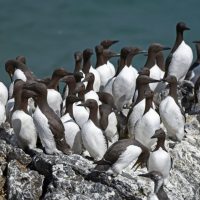Filter Results
Snails and their shells: Capstone research in the Burke Museum’s shell collection
Walk along any beach, and you’re likely to find snail shells dotting the sand. In the Bering Sea, more than 200 species of sea snails exist. They’re an important source of prey for fish and walruses, playing a vital part in the Bering Sea food web. Working with a 50-year-old shell collection sourced from NOAA trawls from the mid-late 1970s, Jasper Nevis is looking at community structure in Bering Sea snails in collaboration with the Burke Museum Malacology Collection.
Read moreGhostly flight species of baleen whales avoid attracting killer whales by singing too low to be heard
Killer whales are the only natural predator of baleen whales. More solitary than toothed whales, baleen whales face predatory attacks from killer whales, especially mother and calf pairs. When attacked, some species fight back, while others choose flight. But whale species also produce loud underwater songs…what stops killer whales from homing in on their calls and attacking them? New acoustic research by Trevor Branch sheds light on why.
Read moreTurning up the heat: Revealing lake hotspots using mobile data
You may think aquatic and fishery science is all about fish, whales and oceans, but Iris Haley’s research is demonstrating that essentially anything to do with water is related to this field of study. What is Iris, a SAFS undergrad, investigating? The link between lake visitation and its relationship with heatwaves using cellphone data!
Read moreA Crab Network is Connecting Communities and Generating Crucial Data for Salish Sea Fisheries
A collaborative network of agency and tribal scientists and resource managers, university faculty and students, and community volunteers are diligently working together to unlock the secrets of the Dungeness crab’s life cycle in the Salish Sea. The Pacific Northwest Crab Research Group (PCRG) is leading this unprecedented effort, generating vital data and fostering robust relationships to ensure the long-term sustainability of this ecologically, economically and culturally-important species.
Read moreSmall-scale fisheries essential to global nutrition, featured on cover of Nature
Small-scale fisheries play a significant but overlooked role in global fisheries production and are key to addressing hunger and malnutrition while supporting livelihoods around the world, according to research featured in Nature in Jan. 2025. The study was published by an international team of scientists, including Professor Chris Anderson from the UW SAFS.
Read morePresenting at the 2024 International Society for Behavioral Ecology Congress: a graduate student’s experience
Ashley Townes writes about her experience presenting her doctoral research at the International Society for Behavioral Ecology (ISBE) Congress in Melbourne, Australia in the fall of 2024, describing it as an incredibly profound experience. Engaging with fellow researchers and ecologists from around the globe, all passionate and committed to the field of behavioral ecology enriched her perspective and deepened her own commitment to her research.
Read moreA return to his roots: SAFS undergrad conducts research in Hawai’i during HPP internship
Dash Dicksion, a SAFS undergrad, got to return to his home island of Oahu during his NOAA HPP internship in the summer of 2024, working with the Ecosystem Sciences Division of NOAA’s Pacific Islands Fisheries Science Center. He spent 30 days at sea, plus time in the lab, focused on the biocultural and ecological aspects of fish larvae across Hawai’i Pae ‘Aina (the Hawaiian archipelago).
Read moreBeyond despair: How can ecosystem restoration enhance human wellbeing?
Ecosystem restoration has historically had a very ecological focus. However, while teaching a special interdisciplinary class during her time at Duke University, SAFS Assistant Professor, Carter Smith, took a slightly different view: how can ecosystem restoration be used to directly improve human wellbeing?
Read moreSurveys show full scale of massive die-off of common murres following the ‘warm blob’ in the Pacific Ocean
A University of Washington citizen science program — which trains coastal residents to search local beaches and document dead birds — has contributed to a new study, led by federal scientists, documenting the devastating effect of warming waters on common murres in Alaska.
Read moreEvolution and elongation in deep dwelling anglerfishes
Working with specimens from the Burke Museum and NOAA, Elizabeth Miller, a former postdoc at SAFS, was captivated by the great diversity of shapes of anglers, which was at odds with how the species is often depicted in popular culture (think Finding Nemo). Elizabeth set out to build a family tree of anglerfishes and delve into the evolution of new shapes, such as body elongation.
Read more